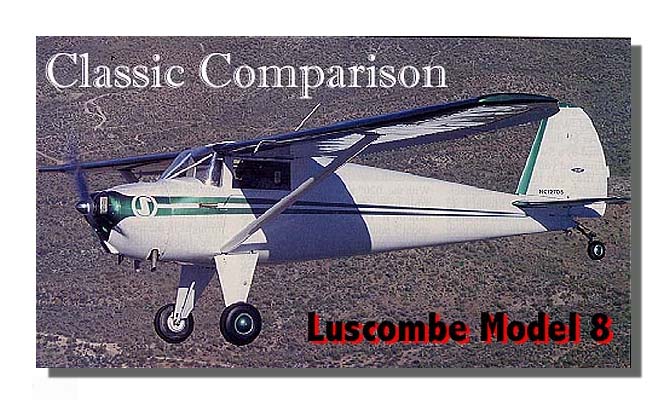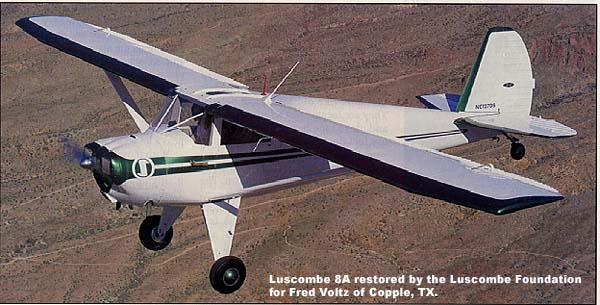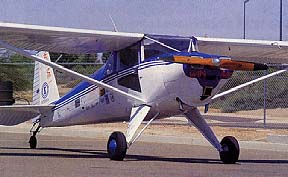

Not too long ago Luscombes shared a dubious honor with the Taylorcraft. They were voted "The Airplane Most Likely to be Abandoned on the Back Tiedown Line." A ratty Luscombe was the rule, not the exception. Although you'd occasionally see fantastically polished, beautifully detailed Luscombes, you were far more likely to see airplanes with dull, spotted skin, scaling paint and small weird animals in residence in nooks and crannies.
From the beginning, however, those who loved Luscombes, LOVED Luscombes. They had gotten past the old-wive's tales about it's supposedly "squirrely" ground handling, found out the truth and gloried in the fact that they were flying a sporty little airplane at bargain basement prices. Even today, when we are supposedly much more enlightened, the Luscombe stands somewhere near the back end of the classic aircraft pack, when it comes to prices. They are still a bargain. Much more important, they aren't as hard to fly as the grape vine would have them. More on that later.
Several things make the Luscombe an ideal restoration project. For one thing, they are tiny. Without the wings, they'd fit into a garage (or upstairs bedroom, if you don't tell mom) without even being tight. Secondly, there are approximately 2,500 flying with another 1,000 estimated to be in barns, attics and workshops, and an unknown number disassembled for parts. This is another way of saying that finding assistance and parts isn't difficult.
What makes the parts and assistance aspect of supporting or rebuilding a Luscombe much easier than other airplanes is that technically the parts are still in production. Although they didn't mean to get into the parts business, the Don Luscombe Aviation History Foundation, in Chandler, Arizona, has all the drawings, the Type Certificate and some of the original tooling. See the separate side bar for what services they provide, but suffice it to say, they make owning a Luscombe easy.

Mechanical Description
The Luscombe Model 8, like the Phantom before it, was well ahead of its time. Don Luscombe got the first Model 8 going as part of a class project in one of his aviation trade schools and it went into production in 1938/39. It is worth noting that the airplane was the very first commercially successful all-aluminum light aircraft, although aircraft like the Buhl Pup had used the same material much earlier. By the time the war shut Luscombe down, the airplanes were selling extremely well, a fact not lost on Cessna, when they began post war production of the 120/140.
The postwar airframes differed in a myriad of tiny details from the pre-war airplanes. Some of the changes are significant, but most are merely interesting. When the company was taken over by the War Department (it was owned by a Swiss foreign national at the time and you KNOW how dangerous they can be in wartime) to produce sub-components, it's engineering staff never forgot the Model 8. In their off hours, they continued up-dating the airframe and, when they went back into production in late 1946, the result was an airplane that took advantage of what they'd learned during the war.
Post war wing ribs, for instance, are stampings in the rag-wings and almost non-existent in the metal wings. The metal wings use curved, hat-section (actually derby shaped) stampings to hold their shape with no webs. Pre-war ribs are traditional aluminum truss units. The spars, beginning to end, never changed.
Most of the airplane's components were refined for easier production. After the war they continued this process and in 1947 introduced the "square" tail. It took some months to use up existing inventory plus, since the two styles of tails are intechangeable it's not unusual to see late tails on early airplanes and vice versa.

There are two basic wing designs, the double strut rag wing and the single strut, stressed skin aluminum post war wing. The rag wing was offered as an option after the metal wing was introduced until available stock ran out sometime in late '46 or '47.
The original wings used .016 aluminum leading edges which was easily damaged, especially in the pre-war wings which used a softer aluminum. The metal wing was certificated with .016" but immediately went to .020" because of availability problems with the thinner material. They later listed the heavier skins as an option with the .016" being standard. With the .020" skin an option, it's possible to see metal wings with either skin on it. The weight difference was about 7 pounds an airplane.
Just for the record: It's often assumed the older rag wing airplanes were lighter, but no one seemed to know exactly how much. Doug Combs of the Luscombe Foundation says the rag-wings save 56 pounds an airplane. For such little birds, that's a sizable amount.
The metal wings originally had only a few inspection panels , but corrosion concerns prompted a Service Bulletin from the Foundation followed by an AD to install two more inspection panels mid-wing. Since you're looking at a ten foot long closed aluminum box that's at least 50 years old, that seems like a sensible thing to do.
Corrosion is, as with any aluminum airplane, an area of constant concern with the Luscombe. Luscombes suffered more than most of its peer group because there was at least a 25 year period during which Luscombes were worth very little and a hangared Luscombe was rare. The vast majority of the population sat outside for most of their life.
Doug Combs says 10-20% of the airplanes have some corrosion somewhere and it is often a function of where they spent most of their time. He says corrosion spawns an oxide powder which, in a dry climate, helps stop the corrosion. In a damp climate, however, he says it collects moisture and promotes even more corrosion. For that reason, Luscombes in the damper parts of the country are more suspect than those from the drier western states.
The wings have the standard corrosion problems and the spar carry-throughs in the top of the fuselage require close inspection.
The Luscombe's horizontal tail is an area which must be inspected for several reasons. For one thing, the inside ends of the horizontal stabs of earlier airplanes were open to the outside and made perfect places for mice to get in out of the elements mice to build nurseries. The urinary habits of breeding mice are not conducive to long-lived airplane components.
 The horizontals also need inspecting
because they were often mishandled by owners. The leading edge
of later stabilizers contain ribs that aren't actually riveted
to the spars, so lifting on the leading edge to move the airplane
flexes it. Also, the spars themselves are three piece with a joint
just outboard of the fuselage which introduces a stress concentration.
A tail that would last an eternity in flight can easily sustain
damage through mis-handling. That's why the Foundation has an
STC'd kit for a retractable handle which slides out of the fuselage
to spare stabilizer abuse.
The horizontals also need inspecting
because they were often mishandled by owners. The leading edge
of later stabilizers contain ribs that aren't actually riveted
to the spars, so lifting on the leading edge to move the airplane
flexes it. Also, the spars themselves are three piece with a joint
just outboard of the fuselage which introduces a stress concentration.
A tail that would last an eternity in flight can easily sustain
damage through mis-handling. That's why the Foundation has an
STC'd kit for a retractable handle which slides out of the fuselage
to spare stabilizer abuse.
Doug Combs says the first place he looks for corrosion is at the steel fittings. Dissimilar metal corrosion is also an indication to look elsewhere for that tell tale white powder.
The landing gears of earlier, stock Luscombe's is unique in that the gear legs themselves are cantilevered weldments connected to the center shock absorption spring and hydraulic damper by streamlined tie-rods. Since it's hard to push on a rope (a basic engineering principle), the tie-rods provide no sideload protection and the legs often get bent, cracked or broken. At the very end of the original production run, 1948/49, the Siflex (or Silflex, Luscombe spelled it both ways) gear was introduced. This was a massive piece of swage-tapered tubing with an equally massive welded upper-leg that connected directly to the spring in the middle of the fuselage. This eliminated the tie-rods between the gear legs. The Foundation is making replacement tubing gears but has yet to find a vendor which can do the Siflex gear.
A good alternative to the Siflex gear is using steel push-pull tubes in place of the flexible tie-rods. This what the factory did for float-equipped Luscombes and the tubes are available from the Foundation. They are a factory-approved installation.
The airplanes were, at one time or the other, equipped with every form of brake available including Shinns and Goodyears. They are adequate for flying the airplane, but a real pain to maintain and keep adjusted. The foundation has been doing Cleveland disk conversions on a one-time STC basis and hopes to get an multiple STC soon.
The Luscombe was produced in a wide variety of models, the biggest difference being the engine and wing design. The fuel system was also changed depending on the engine. The 65 hp airplanes usually (not always) had a fuselage tank. However, it was found there wasn't enough head pressure to feed engines 75 hp and larger because of the increased climb angles. For that reason, they went to either one or two wing tanks. The postwar rag wings were originally set up for wing tanks, but they weren't always installed.
Here's a quick breakdown of the models:
8, A-50 engine, a few built "...they'd just as soon forget it..." says Combs.
8A, A-65 Continental, about 4,500 built, rag or metal wings
8B, Lycoming 0-145, only a handful still flying
8C, 1940/41, 75 hp Continental
8D, 75 Continental w/wing tank
8E, Post war, 1946/47, C-85 metal wings, about 5500 built
8F, 1948-1950, C-90, flaps, later updated panel.
8F, 1959-60, Silvaires
GO TO NEXT PAGE FOR FLIGHT CHARACTERISTICS